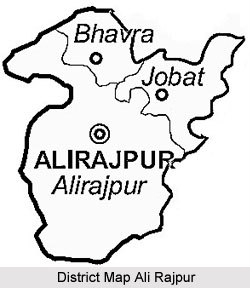 The Princely State of Ali Rajpur was one of the renowned princely states of India that were administered by native rulers or Indian princes under the indirect control of the British Government of India. It was a part of the Bhopawar Agency which was a subdivision of the Central India Agency. It was situated in the Malwa region of Madhya Pradesh, which is near the boundary with Maharashtra and Gujarat. Ali Rajpur state covered a total area of 2165 sq km, and comprised of a total population of 50,185 in the year 1901 and 112,754 in 1941. The native Hindu rulers of the state held the title of Raja and were granted a gun salute of 11 guns. The native flag of the princely state of Ali Rajpur consisted of 12 red and white horizontal stripes. The Princely State of Ali Rajpur was established by the Rajput Rathore dynasty in the year 1437.
The Princely State of Ali Rajpur was one of the renowned princely states of India that were administered by native rulers or Indian princes under the indirect control of the British Government of India. It was a part of the Bhopawar Agency which was a subdivision of the Central India Agency. It was situated in the Malwa region of Madhya Pradesh, which is near the boundary with Maharashtra and Gujarat. Ali Rajpur state covered a total area of 2165 sq km, and comprised of a total population of 50,185 in the year 1901 and 112,754 in 1941. The native Hindu rulers of the state held the title of Raja and were granted a gun salute of 11 guns. The native flag of the princely state of Ali Rajpur consisted of 12 red and white horizontal stripes. The Princely State of Ali Rajpur was established by the Rajput Rathore dynasty in the year 1437.
Raja Surendra Singh was the last ruler of Ali Rajpur, who consequently served as the Ambassador of India to Spain during the 1980s. After the country achieved independence on 15th August 1947, was acceded to the newly formed Union of India. The region was later incorporated as a part of the new state of Madhya Bharat, which was later included into the state of Madhya Pradesh on 1st November 1956. At present Ali Rajpur, also known as Alirajpur, is a municipality and a city in the district of Ali Rajpur in Madhya Pradesh state, India.
The Princely State of Ali Rajpur included 325 villages and 2 towns in 1941 and was in the Malwa Agency. It was the westernmost region of the Central Indian states and was bordered by the district of Panch Mahals of the Province of Bombay and Baria state in the north; by the Narmada River on the south which segregates it from the Khandesh district and Barwani; by Chhota Udepur (Udaipur) in the west; and by the princely states of Jobat, Jhabua, Indore and Gwalior in the east. The state was initially known as Ali Mohan, named after the two forts of Ali and Mohan. The courts of the princely state of Ali Rajpur exercised full civil and criminal jurisdiction. The administration of the state was entrusted to a Diwan who appointed by the Raja. The princely state of Ali Rajpur paid tribute to the princely state of Dhar.



















